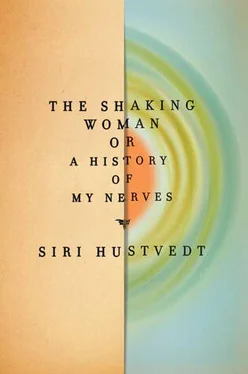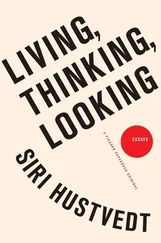The leap from Caius to little Ványa is from the abstract to the particular, from knowing something intellectually to not really knowing it, from general truth to personal truth, from a third-person reality to a first-person reality. The jump also takes us back in time, to the memories of early childhood, to the dear smell of a leather ball and to the sensual presence of a mother, to a world that revolved around little Ványa, His Majesty the baby, the beloved little boy. It is so ordinary, this denial of the inevitable, the thing that must come, the end of me, but how hard it is to truly comprehend. Tolstoy uses the pronoun It to describe the lurking presence in the life of Iván Ilých, one our hero desperately tries to avoid. He looks for “consolations — new screens — and new screens were found and for a while seemed to save him, but then they immediately fell to pieces or rather became transparent, as if It penetrated them and nothing could veil It .” Like Mrs. A., who poured her grief into missing glasses and cigarettes, Iván Ilých worries over scratches on his polished table and a torn album and then falls into a quarrel with his wife and daughter over where to keep the damaged album, and finds that these trivial disputes are also saving screens: “But that was all right, for then he did not think about It. It was invisible.” 105 It denotes an alien, the not-I, whether the strange animal forces of desire and aggression that seem to live in us or the terrible reality that those powers aren’t eternal, that they end in a corpse, in thingness, the inanimate, the once-I, now an it.
THE FIRST TIME I SHOOK I was standing on home ground. It wasn’t only that my father had taught for many years at the college. As a child, I had lived on that campus because my professor father had a second job as head resident of a men’s dormitory. That old building has since been torn down, but I remember its murky hallways, its smells, the elevator with its red door, the soda pop machine glowing on the floor below us, and the button on it for Royal Crown Cola. I remember the fat, kind janitor, Bud, with his dusty gray pants, the forbidden upper floors where my sister Liv and I ventured a couple of times. I remember the view from the window in our apartment, where I stood one Easter and cried. On that day of hats and gloves and light spring dresses, convention dictated warm and sunny, but what I saw through the window was snow. I remember when I learned to ride a bicycle on that same ground one spring, and the feeling I had when my father let go of the bike and I pedaled off alone, weaving a little, but joyous the moment I understood I had been released and was still upright. I remember the power plant, where my father took me and Liv through the billowing white smoke and the blast of heat and the roar of machinery into a small room near the back of the building where a man made ice cream and gave us samples for free. I remember lying over the grates outside the library and studying the candy wrappers and cigarette butts and various kinds of debris that had fallen down there, and how absorbing it was just to look at those things. We moved outside town before I entered the third grade, but aside from a few fragments from my third and fourth years, my autobiographical memory from five through nine is largely fixed on that campus. Places have power.
Did standing there on that familiar ground unleash the reality of death for me — the presence of an unspeakable It ? After all, I live in New York and didn’t see my father on a daily basis. In New York it was ordinary that he should be missing from my life. Was I thrown into a subliminal realization that his absence was permanent, irrevocable, without being consciously aware of the turn taken inside me? Did the faces of people I knew from my childhood hurl me back to an earlier self? Did the shuddering have something to do with occupying my father’s place? Quite literally, standing in a place I felt belonged to him? Was the sight of that green lawn outside Old Main, where my father once had his office, the image of which is scratched into my memory because I walked there again and again, not only as a child but as a girl, and then as a young woman when I was a student? But it wasn’t the vision of the place that started the convulsion; it was the act of speaking. It began with the first word and ended with the last. Was it connected to a memory?
EXPLICIT MEMORIES THRIVE ON PLACES. Classical theories argued that to do their work memories require locations— topoi. Cicero credited Simonides of Ceos for creating an art of memory. When an earthquake hit a banquet hall and killed everyone in the room, Simonides, who had been called away from the festivites, returned and was able to identify the crushed bodies because he remembered where each guest had been sitting. From this gruesome event, the story goes, Simonides discovered the essential connection between locality and memory. Through his reading of Aristotle, the scholastic philosopher Albertus Magnus (d. 1280) proposed that mental places serve a practical purpose for the mind and make it easier to retrieve memories. They are not mirrors of reality but, rather, internal conceptions of it. 106Cicero developed the idea of locus as a tool for verbal memory. A speaker could memorize a long speech by visualizing a house and strolling through it, attaching each part of his talk to a different spot, a table or a rug or a door in the various rooms. My father used this technique to memorize his speeches, and it seemed to work well. Walking through an imagined architecture becomes the space in which one can fix sequential, verbal thoughts. Freud’s commentary about the more primitive character of the visual mental image as opposed to words is pertinent. My visual memory is often rather static, and I remember best intimate places — houses, woods, fields, and streets I have memorized because they were experienced again and again as the backdrop of my life. They are spaces I have lived in or with over time.
On the other hand, a place I visited only once often grows dim. I may have a vague sense, a schema, if you will, of walking down a street in Hong Kong, for example, but what stands out in my memory is a beggar kneeling in the street who grabs the hem of my dress and I recoil. Repugnance, pity, and guilt visit me in turn, but the image of the man’s face, which I know frightened me with its desperation, is no longer vivid. I can reinvent it in my mind’s eye, as the apt saying goes. He has rotting teeth, bloodshot eyes, dirty cheeks. What I actually retain is the knowledge that it happened and that I have thought about it a number of times since, but the words I use to tell myself the story have supplanted any detailed picture. Hong Kong was filled with beggars in 1975. I remember this in a general, factual way, but I can no longer summon visual imagery that isn’t a vague jumble reconfigured into an impressionistic, imprecise version of my experience. Language abstracts visual memory and, in time, often replaces it by creating a fixed narrative that can be repeated again and again.
A more striking example of place as the theater of memory can be found in an error I discovered about my own recollections. One of my earliest memories is from when I was four. It took place at my aunt’s house in Bergen, Norway, at a family meal. The chief visual components of the incident consist of the familiar table in the familiar living room with its window overlooking the fjord. I can see that room clearly in my mind because, thirteen years later, I lived with my aunt and uncle in that house. I also recall a few definite, sequential movements. I was sitting in a chair across from my twelve-year-old cousin, Vibeke, whom I loved and admired, when suddenly, for reasons I didn’t understand, she began to cry. I remember pushing myself off the chair. My legs didn’t reach the floor, so I had to slip to the ground. I walked over to my cousin and patted her back in an effort to comfort her. The grown-ups began to laugh, and I was seized by burning humiliation. The memory has never left me. I now understand that the adults’ laughter wasn’t malicious, but the assault on my dignity has lasted, and it shaped my motherhood with my own daughter. I remembered, to quote Joe Brainard, “that life was just as serious then as it is now,” that children must be respected as well as loved. The mistake I made was not about my emotion but about where I had been when my pride was wounded. This bump to my self-esteem could not possibly have taken place in the house I remembered because when I was four years old that house had not yet been built . I reassigned the memory to a place I could remember, rather than the one I had forgotten. As Albertus Magnus argued: the room served a useful purpose. I needed to root the event somewhere in order to retain it. It required a visual home or it would float away unanchored. Like the ancient and medieval memory experts, I attached my now mostly verbal scenario to a locus .
Читать дальше












